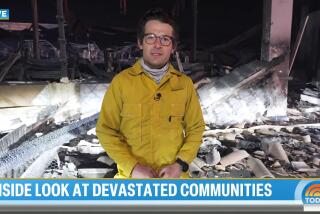Editorial: We’re running out of time to rescue the pets that survived the Palisades fire

- Share via
When your house is burning to the ground, it’s a profound relief to get loved ones out. But what if you couldn’t get your pets — your furry loved ones — out? Spooked animals (especially cats) may bolt or hide during the chaos of a family’s frantic departure. In other cases, no human was home to rescue the pets as fire swept through. Dozens or hundreds (or maybe more) people displaced by fires are still hoping to be reunited with hardy pets that survived.
After the Eaton fire, the Pasadena Humane Society took in hundreds of animals as the American Society for the Prevention of Cruelty to Animals and animal control officers helped find and evacuate pets as well as strays. That sort of speedy response is key, because pets in burned areas are at risk of starving, dying of thirst or being attacked by predators.
In Pacific Palisades, few residents have been allowed into the area to search for pets. Nonprofit animal welfare groups with experienced animal rescuers, in general, have also not been allowed in to search.
That must change. Now — before it’s too late and even more beloved pets are lost.
In the wake of a disaster of this scale, municipalities scramble to marshal resources and coordinate offers of help. In Los Angeles, city officials made the decision to allow into evacuation zones only animal control and humane officers from Los Angeles Animal Services, the city’s shelter system, and animal control officers from other local governments. According to Mayor Karen Bass’ spokesman, that was a law enforcement decision to keep residents safe.
But residents are desperate to search for their animals, knowing that a scared, hiding cat or dog will recognize their voices and come to them. Many animals are likely to be wandering the ruins of their homes. Owners have turned to nonprofit animal welfare groups for help. Social Compassion, a nonprofit animal protection group (which has a separate lobbying arm) headed by Judie Mancuso, tried unsuccessfully to get an agreement — a memorandum of understanding — with the city to let their experienced rescue partners go into the burn areas.
It’s past time to let these folks search for pets. Two and half weeks since fire ravaged the Palisades, this mission is more urgent than ever. Mancuso is getting frantic calls from pet owners who expect the city to start bulldozing the area soon. “But we’re still trying to get these animals that are left there out alive,” she said.
It’s not that animal control officers aren’t doing a good job. Many have training in how to deal with disasters. They have been putting out water and feeding stations and looking for cats, dogs and horses, and even trying to protect koi ponds. That’s great. But most animals need to be evacuated.
The city shelter system has made room for hundreds of fire evacuee animals. Nonprofit groups moved animals living in shelters before the fires to other cities. There is also a hotline that people with missing pets can call to leave information about the location of their home and the name of their pet, and people can submit photos to help with identification. Pet owners and animal welfare advocates say that owners initially weren’t getting much feedback or response, but that the system is working better now.
The city could still use the help of animal rescuers with a history of corralling scared animals and expertise in how to set a humane trap, bait it with food and get a cat to walk in. These traps are often accompanied by a camera on the ground next to it and a remote connection so the rescuer can see what went in or brushed against the trap.
Rescuers go in either with a resident or with a list of addresses and pets to look for. Sometimes they manage to get photos of cats they haven’t been able to catch yet.
Lisa Kaas Boyle and her husband lost their house in the Palisades. Their cats, Blue and Vincent, were sighted, separately, and photographed by rescuers. “I have already gone through the mourning process and decided I had lost everything. But then to be sent these photos,” she said. “I thought, ‘Please just give me back those cats and we’ll call it even.’”
We shouldn’t underestimate the profound importance of pets in people’s lives. During Hurricane Katrina, nearly half of the people who refused to evacuate did so because they couldn’t take their pets. In the wake of that disaster, Congress passed the Pets Evacuation and Transportation Standards Act of 2006, requiring the director of the Federal Emergency Management Agency to make sure that local emergency plans include care and shelter for pets and other animals during a disaster.
L.A.’s official response this month has been too slow and, so far, has failed to coordinate enough with nonprofit rescue organizations that are equipped to help in the fire zone. Some rescuers have unofficially slipped into the Palisades over the last couple of weeks. And sometimes the animal control officers on the scene have — unofficially — helped them. That’s terrific. They should all be working together.
Rescuer Valarie Ianniello, who co-founded the animal welfare group Women United for Animal Welfare, says an animal control officer she got to know offered to replenish the food in one of her traps. And when a cat she was trying to find showed up in a trap, it was the animal control officer who called her and said, “I have good news.” Following protocol, the officer took the pet to a shelter.
Ianniello called the owner, who reunited at the shelter with his cat, Toasty, who is 22 years old — and had survived 16 days since the Palisades fire started. “These cats,” Ianniello said, “they really do have nine lives, right?”
More to Read
A cure for the common opinion
Get thought-provoking perspectives with our weekly newsletter.
You may occasionally receive promotional content from the Los Angeles Times.










